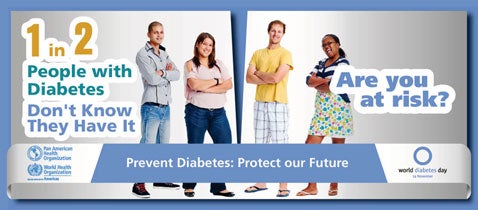

An estimated 371 million people around the world suffer from diabetes, but half are unaware they have the disease, according to data from the International Diabetes Federation. In the Americas, some 10% of the adult population—nearly 63 million people—have diabetes, but an estimated 44% of them don't know it.
On World Diabetes Day, PAHO/WHO recommends: "Know your risk and warning signs, get the care you need"
Washington, D.C., 14 November 2013 (PAHO/WHO) — An estimated 371 million people around the world suffer from diabetes, but half are unaware they have the disease, according to data from the International Diabetes Federation. In the Americas, some 10% of the adult population—nearly 63 million people—have diabetes, but an estimated 44% of them don't know it.
On World Diabetes Day, November 14, the Pan American Health Organization (PAHO), Regional Office of the World Health Organization (WHO), is encouraging people throughout the Americas to learn about the risks and warning signs of diabetes, to take steps to prevent the disease, and, if they develop diabetes, to seek the care they need.
"Understanding diabetes is the first step toward prevention, diagnosis and treatment," said Dr. Alberto Barceló, PAHO/WHO advisor on noncommunicable diseases. "World Diabetes Day is a once-a-year opportunity to raise awareness and reduce the impact of one of the world's fastest-growing health problem, which is reaching epidemic proportions."
Often called a "silent disease," diabetes can develop in people without initially producing symptoms. If not properly managed, diabetes can lead to serious complications, including heart, kidney, vision, and circulatory problems that can lead to permanent disability or even premature death. Diabetes can be prevented or delayed, however, with lifestyle changes.
The leading risk factors for diabetes are family history, lack of exercise, unhealthy diet, and obesity or overweight. Eating healthier foods and being physically active can reduce one's risk of developing type 2 diabetes.
The major warning signs of diabetes are frequent urination, weight loss, lack of energy and excessive thirst. People who experience these signs should get tested and follow their doctors' advice.
But diagnosing diabetes is not just a personal responsibility. "The proportion of people with diabetes who are diagnosed also depends on the ability of medical services to detect new cases," says Barceló. "Diabetes risk assessment and testing need to be integrated into primary care, and services need to be widely accessible to the population."
Improved diabetes prevention, detection and control require healthcare services that are universally accessible, patient-centered and integrated into primary health care along with care for other noncommunicable diseases. In addition, care must be evidence-based and oriented toward prevention as well as empowering patients to better manage their own disease and to prevent complications.
About diabetes
Diabetes mellitus is a chronic metabolic disease characterized by elevated blood glucose (hyperglycemia). It is associated with an absolute or relative deficiency in the secretion and/or action of insulin.
There are three main forms of diabetes: type 1, type 2, and gestational diabetes. Type 2 diabetes is the most common, accounting for 85—90% of cases. It is related to modifiable risk factors including obesity or overweight, physical inactivity, and high-calorie diets of low nutritional value.
PAHO, founded in 1902, is the oldest international public health organization in the world. It works with its member countries to improve the health and the quality of life of the people of the Americas. It serves as the Regional Office for the Americas of WHO and is part of the Inter-American system.
- PAHO diabetes information
- World Diabetes Day
- International Diabetes Federation World Diabetes Day campaign
- http://www.paho.org
- https://www.facebook.com/PAHOWHO
- https://www.youtube.com/pahopin
- https://twitter.com/pahowho #diabetes
Contacts:
Donna Eberwine-Villagran, eberwind@paho.org, Tel. +1 202 974 3122,
Mobile +1 202 316 5469 or Leticia Linn, linnl@paho.org, Tel. + 202 974 3440, Mobile +1 202 701 4005 Knowledge Management
and Communication, OPS/OMS — www.paho.org



